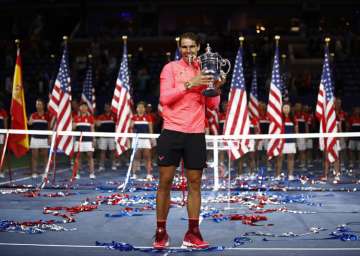Rafael Nadal beats Kevin Anderson to win third US Open, 16th Grand Slam title
Rafael Nadal on Sunday beat South African Kevin Anderson 6-3, 6-3, 6-4 in the US Open final to win his 16th Grand Slam title

Spanish Tennis star Rafael Nadal on Sunday beat South African Kevin Anderson 6-3, 6-3, 6-4 in the US Open final to win his 16th Grand Slam title. It is the third U.S. Open title for Nadal, who won two majors this year for the first time since 2013.
The 28th-seeded Anderson was bidding to become the lowest-ranked U.S. Open champion ever.
Rafael Nadal entered the 2017 Grand Slam season on a 2½-year drought without so much as one appearance in a major final.
“Of course, after a couple of years without competing at this very high, high level,” Nadal said, “very happy to be back.”
The No. 1-ranked Nadal collected his 16th Grand Slam trophy overall and at his news conference, he wore a white T-shirt listing the date and site of each one. Among men, only Roger Federer has more, with 19. Each of those two longtime rivals won two of the four majors this season, marking their return to the heights of their sport.
Nadal has dealt with knee and wrist problems, both likely a result of his physical brand of play, over his career, but 2015 and 2016 were his first seasons without reaching at least one Grand Slam final since 2004, when he was still a teenager.
“I mean, I’ve always said he’s one of the, obviously, greatest players of our sport, obviously feeling very confident,” Anderson said. “He seems to have turned around a lot of those injuries he’s experienced the last couple of years. I guess time will tell on that.”
At No. 32, Anderson was the lowest-ranked U.S. Open men’s finalist since the ATP computer rankings began in 1973. The 31-year-old South African never had been past the quarterfinals at any major tournament in 33 previous appearances.
“I learned a lot of lessons,” Anderson conceded. “It was a difficult match, up against somebody who has been on that stage over 20 times before.”
Nadal added to his U.S. Open triumphs in 2010 and 2013 and improved to 16-7 in Grand Slam finals. For the first time since 2013, he appeared in three in a single season, losing to Federer at the Australian Open in January, then beating Stan Wawrinka for his record 10th French Open trophy in June.
Nadal’s career haul also includes two trophies from Wimbledon and one from the Australian Open. All of his big victories have come while being coached by his uncle, Toni, who is now stepping aside. The U.S. Open was the last Grand Slam event of their partnership.
Not since Pete Sampras at Wimbledon in 2000 had a man won a Slam tournament without facing any opponents ranked in the top 20. In New York, the bracket was weakened by the injury withdrawals of three of the top five men: past champions Andy Murray, Novak Djokovic and Wawrinka.
Nadal also did not face Federer who was eliminated by Juan Martin del Potro in the quarterfinals. Nadal then beat del Potro, the 2009 champion but now ranked 28th, in the semis.
Nadal even came up with some terrific volleys, winning the point on all 16 of his trips to the net. Anderson, meanwhile, finished 16 for 34 in that category.
With Nadal standing way back to receive serves, nearly backing into the line judges, he neutralized Anderson’s most effective skill. Anderson came in having won 103 of 108 service games across six matches, but Nadal accumulated break points at will from the get-go — two in a six-deuce game at 1-all, another two in a five-deuce game at 2-all.
Anderson began trying to end points quickly with a volley. Two problems with that: Anderson is not usually a serve-and-volleyer and so is no expert at that tactic; Nadal is superb at summoning passing shots at extreme speeds and angles, especially when facing the sort of target provided by the 6-foot-8 (2.03-meter) Anderson, the tallest Grand Slam finalist in history.
At 3-all, 30-all, Anderson double-faulted to offer up Nadal’s fifth break point of the match, then badly pushed a forehand wide.
That only made the score 4-3 , but the statistics were telling: Anderson had 21 unforced errors, Nadal just four. A pattern had been established.
“That,” Nadal said, “changed the rest of the match.”
When he broke to lead 4-2 in the second set , that was pretty much that.
“I always accepted all the challenges that my career present to me. The good news and the negative news, I accepted in the same way, in a very natural way. I am a person that I don’t have much ups and downs,” Nadal said. “When I am in a negative moment, I don’t go very down. When I am in a positive moment, probably like now, I don’t believe that I am that good.”
(With AP inputs)